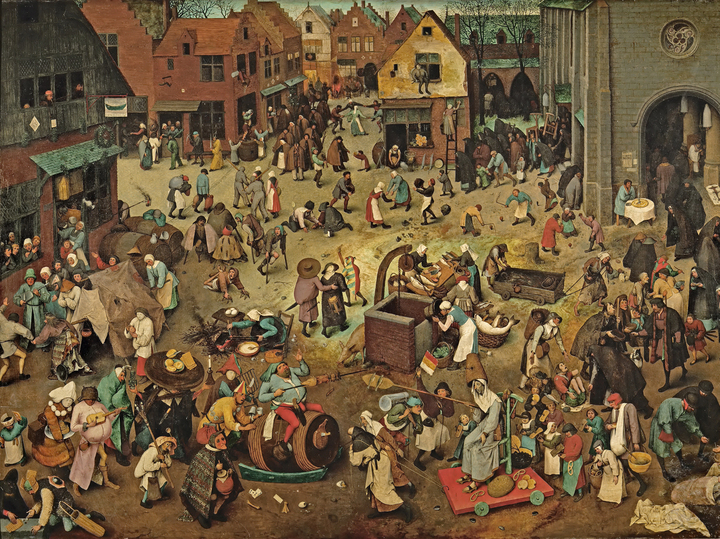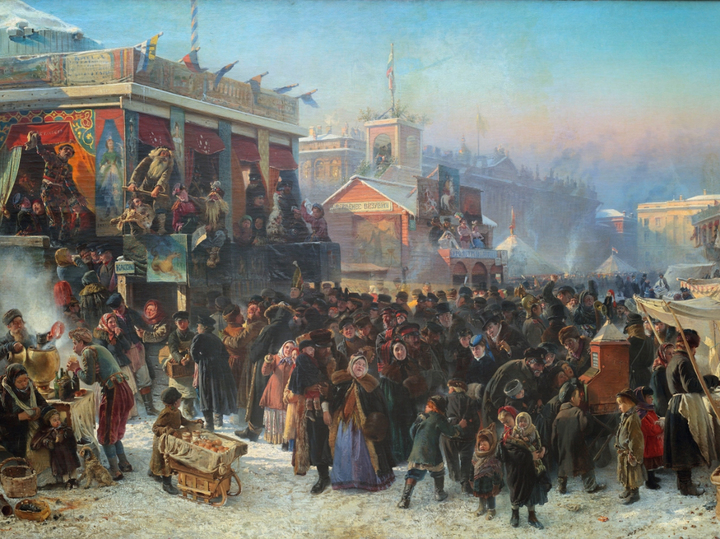Maslenitsa oil painting: top paintings dedicated to seeing off winter and welcoming spring
[ad_1]
Maslenitsa is one of the oldest holidays; on this day, from time immemorial, people have said goodbye to winter and welcomed spring. A thousand years ago, a week before the spring equinox, people began to prepare for the change of seasons. The rituals that arose around the holiday reflect the magical worldview of the Universe. It is not surprising that traditional festivities with pancakes, sleigh rides, battles for snowy cities and the burning of Maslenitsa effigy have been painted by artists many times. “Maslenitsa” paintings reflect not only ritual traditions, each has its own symbolic subtext. We have selected the most iconic of them.
Kustodiev: ghostly rejoicing
The main artist of Maslenitsa is undoubtedly Boris Kustodiev. He turned to this subject more often than others. And not only because I was born on Maslenitsa – March 7th. “You were born on Maslenitsa Thursday and that’s why you probably love pancakes,” his mother wrote. Kustodiev wrote his most famous “Maslenitsa” in 1916. The First World War was going on outside the window. Revolution and famine were approaching. The artist himself is already confined to a wheelchair. At night he screamed in pain, his body ached, his arms hurt, he worked lying down.
During this difficult period of his life, Kustodiev wrote the most vivid, temperamental, cheerful works. As if in spite of fate and illness, all adversity. The painting “Maslenitsa” is one of his main works. It was highly appreciated by the teacher Ilya Repin, and not only by him: the Academy of Arts purchased it from the exhibition for 1,750 rubles.
The plot was born from the author’s imagination. Before us is a pink sunset with yellowish clouds. Dashing troikas are flying along the snow-covered hills. What is stunning here is the panorama, which creates a feeling of flight, and the exquisitely painted details. However, the festive rejoicing is combined with an involuntary feeling of the fabulousness and illusory nature of the world, because in life everything was not so rosy.
Kustodiev returned to the topic of Maslenitsa more than once. The famous portrait of Fyodor Chaliapin (1922) was painted against the backdrop of festivities to mark the end of winter. And the last and one of the master’s main works, “Russian Venus” (1925–1926), seems to be also connected with Maslenitsa. In the window, behind the figure of a buxom maiden, one can see a winter landscape and a trio of horses, and the very image of a naked, yet modest and spontaneous girl probably refers to the last day of the holiday – Forgiveness Sunday. On this day, it is customary to take a steam bath to wash away sins, cleanse the body, mind, and soul. In this plot, which is called “Kustodiev’s Venus” and which set a new trend in beauty, there is a feeling of borderliness, confessionality, and secrecy. Obviously, the artist put his own worldview into it. Moreover, he did not regret the earlier canvas, where he painted himself with his family on the veranda, so that on its back he could leave his last message to the world.
Bruegel: the battle of vanities
Not only Russian artists painted Maslenitsa. One of the world’s most famous stories on the theme of seeing off winter belongs to the brush of Pieter Bruegel the Elder. “The Battle of Maslenitsa and Lent” was written in 1559. The carnival action takes place in the square of a certain Flemish town. There are a lot of people near the cathedral, everyone busy with their own things. Absurdity and subtle humor can be read in the plot. Some dance in circles, others attack someone with bats, and others play dice on the ground. Some sell fish, some drink wine straight from the barrel. The nuns are pulling a cart with Maslenitsa sitting on a chair, at her feet are cheesecakes and rolls, and in her hands is a shovel on which two herrings lie lonely. Beggars immediately beg for alms, and a legless disabled person rolls on the floor with a distorted face. Everything is mixed up here – good and evil, hospitality and poverty, vice and righteousness. Life is like nature—its contrasts appear all at once. Before us is a living human anthill, filled with movement and bustle, which we look at from above, as if from heaven, understanding all the pettiness of worldly affairs.

Makovsky: “choral” Maslenitsa
The famous painting, for which Konstantin Makovsky received the title of professor at the Academy of Arts, was first shown in 1869. The monumental canvas (215 x 321 cm) “Folk festivities during Maslenitsa on Admiralty Square in St. Petersburg” became one of the most iconic for the master. After this triumph, he left the St. Petersburg artel of artists and opened his own workshop on Palace Square.
The painting is synonymous with the painting by Bruegel the Elder. She is no less alive, we watch the festive festivities as if in a movie. Nearby are dandies and the poor, street performances and shops selling goodies, crying children in rags and plump ladies. “Maslenitsa disturbed decorous St. Petersburg with its popular riots; the village burst in and encamped very close to the Winter Palace. The chukhns with their furry ropes rang like bells, smartly inviting them to ride to booths for “a nickel of kopecks,” wrote the artist’s daughter Elena Makovskaya about the painting.

What we see here are not just festivities, they manifest the idea of the sixties of the 19th century, popular sentiments, and the spirit of democracy. The intelligentsia, including the artistic, were inspired by the reforms of Alexander II, especially the decree abolishing serfdom. There is an active discussion about the future of Russia and the role of culture in its development, Westerners argue with Slavophiles, it seems that now the country will follow some other path. Contemporaries described this historical moment as the “era of accusatory heat” and the “era of glasnost,” which will end after some ten years. Makovsky’s painting reflects this mood of the time.
Newspaper headline:
Maslenitsa with oil
[ad_2]
Source link








